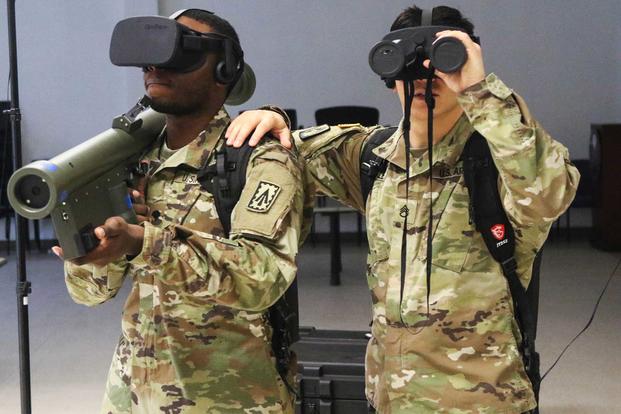The U.S. Army is gearing to launch the first iterations of its new virtual reality simulators, which will lay the foundation for synthetic training environments at multiple bases, officials said this week.
A squad advanced marksmanship trainer will be delivered to more than 20 Army locations next year for close-combat troops, said Maj. Gen. Maria Gervais, deputy commanding general of the Army's Combined Arms Center-Training and director of the Synthetic Training Environments Cross-Functional Team. A squad immersive virtual trainer will closely follow, she said.
The building blocks that will become the synthetic training environment, or STE, will eventually include computer-generated avatars incorporated into the battlespace, among other virtual military elements.
The surroundings the trainers simulate will represent real environments around the globe, from "mega-cities" to dense urban areas, the Army said. The service is collecting data to reconstruct cities, mountainsides, bunkers and more to more accurately represent what soldiers will see in the virtual-reality environment. Officials said that poses a challenge, but service members must get an accurate representation of what they may face in combat.
Related content:
- Army Begins Field Testing Remotely Operated Weapon Station on Strykers
- Army, Marines to Buy Thousands of New Binocular-Style Night-Vision Goggles
- AUSA Conference
The new tools will give soldiers more realistic combat scenarios, "enabling units to enter live training at a much higher level of proficiency," Gervais said during the annual Association of the U.S. Army Annual Meeting and Exposition. The goal is to rely less on bulky hardware for simulations, and more on software and networks, including virtual reality goggles and iPads for streaming services.
Elements of STE, such as One World Terrain -- a Google Earth-like concept that gives soldiers any global terrain at the touch of a button -- have already been tested, she said. Another test is set for March 2019.
While the Army is also looking for more personalized training, Gervais said the new, simulated environments are intended to boost the collective squad, which would face a high-end threat together.
"I'm looking at it from a collective -- a squad, a crew, a team, a platoon and then on up," she said. "But we have to get the individual piece correct in order to be able to do that."
Referencing the service's unusually swift acquisition effort and collaboration with industry, Gervais said the cross-functional team had been asked to be disruptive, and she believed they had done just that.
Feedback between scientists, software developers, industry and soldiers has been ongoing, she said.
The Army wants to leverage ideas from the $5.2 billion gaming industry, "and that's growing everyday," she added.
-- Oriana Pawlyk can be reached at oriana.pawlyk@military.com. Follow her on Twitter at @Oriana0214.










